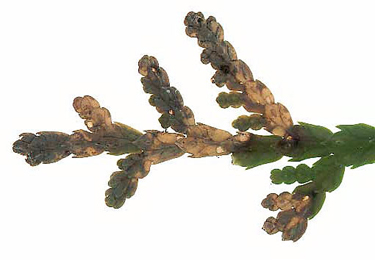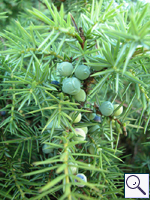|
||||||
|
JUNIPERUS. Junipers. [Cupressaceae] |
|
|
Seven species and subspecies of Juniperus are recorded in Britain. Six British miners are recorded on Juniperus. A key to the European miners recorded on Juniperus is provided in Bladmineerders van Europa. |
|
|
Key for the identification of the known mines of British |
1# > Leaf-miner: Details unknown. |
|
Gelechia senticetella (Hübner, 1817) [Lepidoptera: Gelechiidae]. |
1a > Leaf-miner: The young larvae mine one or two needles. Later they live free in a communal web in which also much frass and remants of needles are stuck. |
|
Dichomeris marginella (Fabricius, 1781) [Lepidoptera: Gelechiidae]. |
1b > Leaf-miner: The larvae mines several leaves out, working from the base to the tip. It migrates to the next leaf by way of a short corridor in the bark of the twig. The larva therefore does not need to make openings in the needles for entrance or exit. Pupation external, in a spinning on the twig. |
|
Argyresthia abdominalis Zeller, 1839 [Lepidoptera: Yponomeutidae]. |
1c > Leaf-miner: The larva enters a needle by making a circular entrance, which is closed with silk. The needle is more or less completely mined out, after which the larva leaves the mine either througth the first opening, or by making a new one. This procedure is repeated a number of times. The mines hardly contain any frass. Pupation in the ground. |
|
Argyresthia aurulentella Stainton, 1849 [Lepidoptera: Yponomeutidae]. |
1d > Leaf-miner: Oviposition on a young shoot. The larva penetrates a leaf, empties it, leaves it, often by making another hole in the epidermis, and starts a new mine. Older larvae bore in a twig. Pupation external. Mines twigs rurn brown and are dropped. |
 Mines of Argyresthia trifasciata on Thuja occidentalis Image: © Willem Ellis (Bladmineerders van Europa) |
|
Argyresthia trifasciata Staudinger, 1871 [Lepidoptera: Yponomeutidae]. |
1e > Leaf-miner: During autumn the larva mines a mere 9-12 leaves - the damage is quite inconspicuous. Hibernation occurs within the mine, and during mild days feeding may continue. After hibernation the larva lives as a borer, and empties 4-6 shoots, over a length of 0.5 - 2.5 mm, just below the tip of the shoot. The damaged shoots wilt and die off. |
|
Argyresthia cupressella Walsingham, 1890 [Lepidoptera: Yponomeutidae] |
| Last updated 05-Jul-2019 Brian Pitkin | ||

